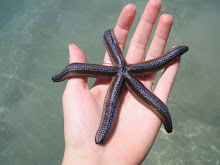As we pulled up to our sampling station the other afternoon, we were getting our supplies ready when I saw a whale surface in the distance. I pointed in that direction and said, "whales." The winch had started and the others hadn't heard, so I repeated the gesture again, a little louder and more enthused when I saw it surface again. Just as they stopped to look, there was a huge burst of air and water directly behind me. I turned around and saw the huge, dense back of a humpback whale gliding across the surface of the water not fifteen feet from our zodiak! The whale showed us it's classic tail fin as we stood in awe, silently. After it disappeared beneath the surface, someone uttered a "wow," followed by a moment of happy laughter. I told you, whales. They continued to surface for a while, getting farther away as we sent our water sampling bottles down one hundred and fifty feet.
This experience was worthy of an email to the boss on the ship. He is somewhat jealous of the attention that whales receive, outcompeting bacteria for the spotlight. His one valid point is that once a sighting is relayed to others, everyone rushes to the windows and onto the deck to gaze out at an empty horizon - a whale doesn't linger long; such a tease. The boss is somewhat jaded about whale sightings and even questions their existence, jokingly, of course. When he shared his feelings with me about whales, I couldn't help but think of Christopher Moore's novel, Fluke.
In truth, humpback whales are very real and swim quietly throughout all of the world's oceans as perhaps one of the most charismatic yet unassuming marine creatures on the planet. Humpback whales are famous for their song, and many researchers have argued that their vocalizations, among other behavioral traits, are evidence for whale culture. One such cooperative behavior is known as bubble net feeding. A group of whales dives down underneath a school of unsuspecting fish and start swimming in a circle blowing bubbles. They swim in smaller and smaller circles until the moment when they all surge toward the surface, mouths gaping. Feeding frenzy. Aside from these orchestrated sprees, humpbacks can stun their prey with their flippers. They eat so much in the summer that they live off their blubber throughout the long, cold winter.
It is true, whales are elusive and sightings are fleeting moments, but they are recurring moments for those who are patient. One cozy evening, I was reading quietly in the dining room and saw several whales surface in the outer harbor. I told others who quickly came to the window to look, but, of course, they never did see any that way. I enjoyed them for at least twenty minutes, just watching. I think the ones in the harbor were actually minke whales, distinguished from the humpbacks by their small size and dorsal fin that is actually shaped similarly to that of a dolphin's. Seeing that whale so close to our boat was a wonderful experience - one of those moments that so quickly reminds you where you are. Not that I easily lose sight of the mountain range, the beautiful islands, or the lone penguins flying through the water, but it is easy to get caught up in your obligations, science fieldwork or otherwise. Whales are such an interesting component of the wildlife here and have their own peaceful personality in my mind, especially compared with the louder and more gregarious seals and penguins. The following might seem like a strange commment, but perhaps what I love most about the wildlife here is that the animals are just living completely naturally, regardless of our presence - they make me feel like the visitor that I am.
Saturday, January 16, 2010
Subscribe to:
Post Comments (Atom)






No comments:
Post a Comment